Insights and news from the ATOM Mobility team
We started our blog to share free valuable information about the mobility industry: inspirational stories, financial analysis, marketing ideas, practical tips, new feature announcements and more.
We started our blog to share free valuable information about the mobility industry: inspirational stories, financial analysis, marketing ideas, practical tips, new feature announcements and more.
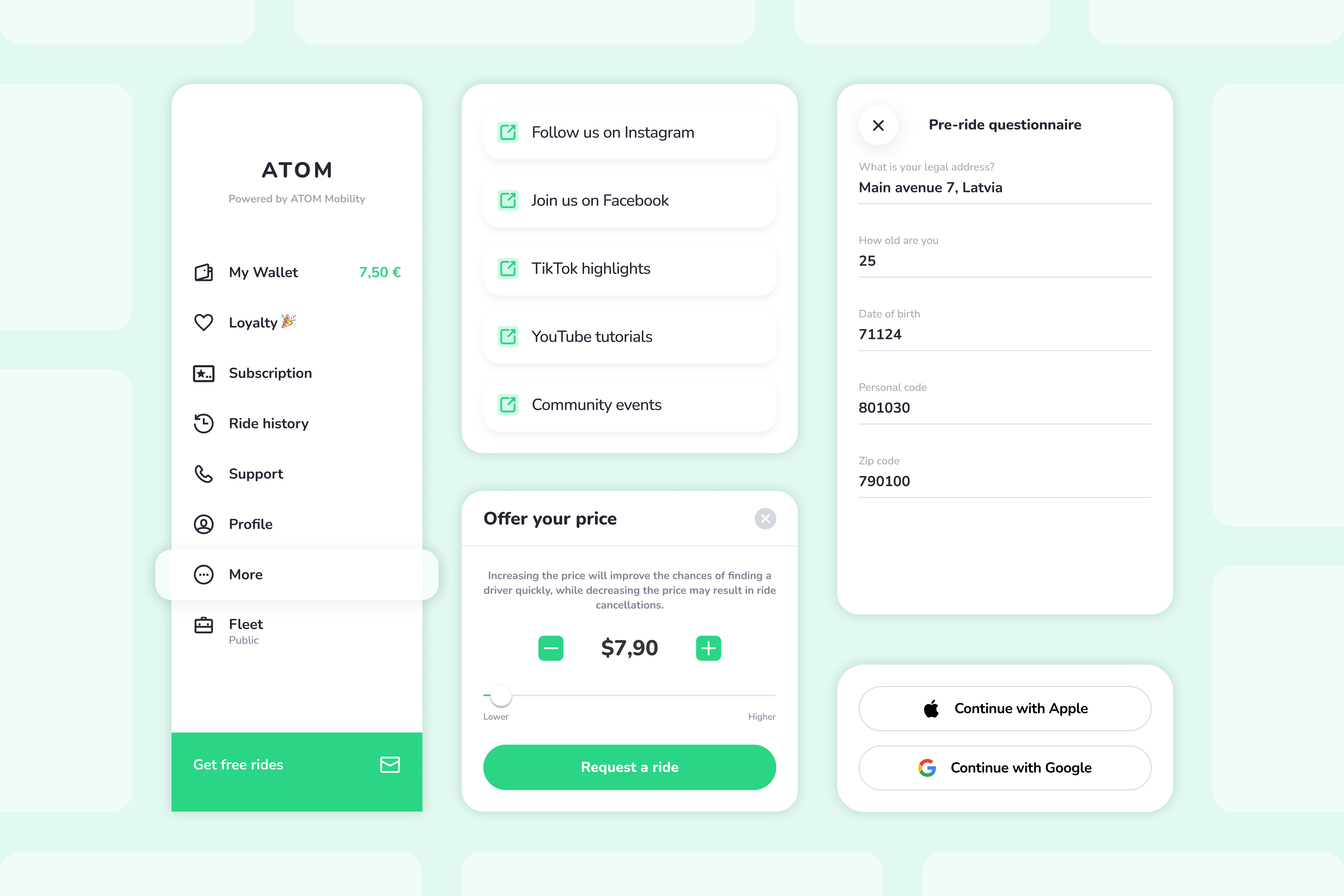
🚀📱2025 was all about automating more and reducing friction across mobility. ATOM Mobility introduced OpenAPI, new sign-in flows, a rental web-booker, smarter fleet automation, and a wide range of new hardware and payment integrations. A faster, more flexible, more scalable mobility platform - built for operators who want to grow.
2025 has been a defining year for shared mobility, digital rentals, and ride-hailing. Competition is stronger, operational costs are rising, and users expect instant, reliable digital experiences. Operators who succeed are the ones who automate more, reduce friction, and stay flexible with hardware, payments, and integrations.
This year, ATOM Mobility shipped a series of features designed to help operators achieve exactly that:
grow revenue, reduce costs, improve fleet quality, and scale into new markets with less complexity.
Here are the 10 most impactful (out of more than 70) features ATOM Mobility released in 2025, and why they matter.

The launch of ATOM’s OpenAPI marks a major step forward for operators seeking greater flexibility, automation, and integration possibilities.
What it is
A fully documented API layer allowing operators and partners to build custom flows, integrations, booking systems, analytics dashboards, or MaaS connections on top of ATOM Mobility.
Who it helps
All verticals: micromobility, car-sharing, moped sharing, rentals, ride-hail, and enterprise partners.
How it works
OpenAPI enables third-party developers to build on top of the ATOM Mobility infrastructure, allowing seamless integrations with external apps, internal tools, and automated workflows. With OpenAPI, operators can extend their service in almost any direction: a partner app (like FreeNow or Uber) can show your vehicles, unlock them, and process payments on your behalf; or internal systems can trigger automated actions - such as sending a survey email after every completed ride. The possibilities are nearly unlimited, giving operators full flexibility to innovate and scale however they choose.
Why it matters
- Enables deeper integrations with partners and local platforms
- Supports custom business logic and automations
- Makes it easier to enter new markets with local-specific requirements
- Opens the door to MaaS distribution and enterprise collaborations

Across mobility, the registration flow is often the first point of friction. ATOM Mobility introduced modern authentication options to simplify onboarding.
What it is
One-tap sign-in using Apple ID or Google Account instead of relying solely on SMS verification.
Who it helps
All operators - especially those targeting tourists, or markets with unreliable SMS delivery.
How it works
When creating a new account or logging in, users can choose to log in/register using Apple ID or Google Account - this will allow account creation in just 2 taps.
Why it matters
- Faster user onboarding experience -> happier rider -> more frequent rides
- Fewer SMS-related issues (and lower SMS related costs) and failed verifications
- Reduced support load from login problems

What it is
A customizable slot in the app menu where operators can add up to five external links - websites, ecommerce pages, tour pages, extra FAQ pages, social media, partner offers, etc.
How it works
- Enable in Settings → System preferences → External links
- Add titles + URLs
- Links automaticaly appear in the app under “More”
Value for operators
- A space where you can display any information you consider important for the user
- Supports cross-promotion and partnership campaigns
- Allows communication updates without app releases
- Creates additional monetisation opportunities, such as launching your own e-commerce or merchandise shop
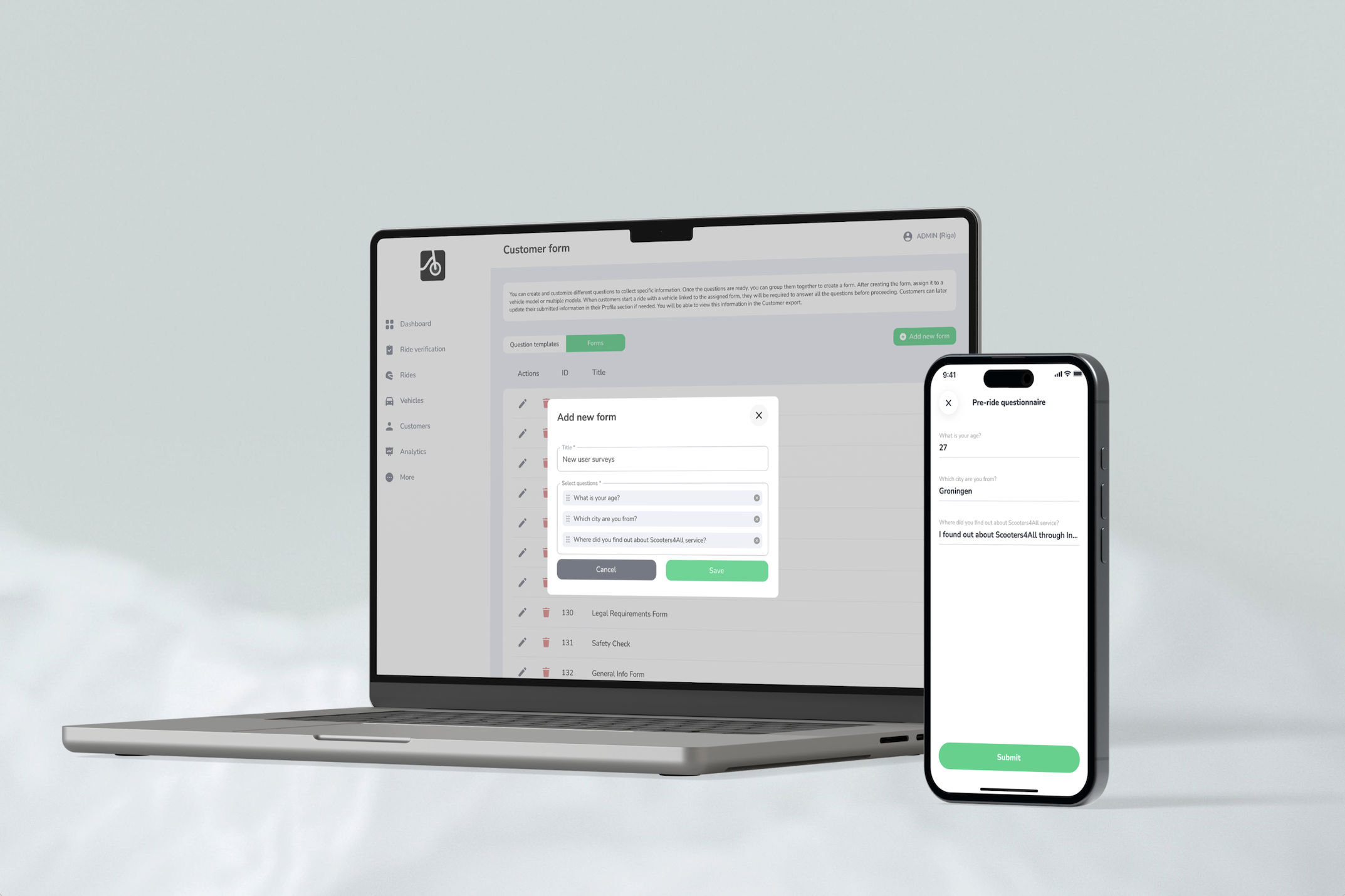
What it is
A form that users must complete before starting a ride - ideal for compliance, reporting, invoicing, or gathering important data.
Who it helps
Operators needing regulatory data, reporting, consent collection, or structured user feedback.
How it works
Create a question (or several) in “Customer form” -> Group questions into a pre-ride form -> Assign a form to specific vehicle models/classes.
Once completed, the customer must answer predefined questions before starting the ride. Their responses appear in both customer and ride exports. For example, you can ask for a personal ID code, legal address, or any other required information.
Value for operators
- Helps meet regulatory or municipal requirements
- Ensures correct invoicing details
- Provides a structured way to capture essential user data
What it is
Automatic payout splitting: driver earnings go to the driver’s payout account, and platform commission goes to the operator - all processed automatically after each ride.
Who it helps
Ride-hail operators using Stripe or Adyen.
How it works
- Operator has a Stripe/Adyen merchant account
- Drivers onboard as payout recipients
- After completed rides, payouts split automatically
- Supports mixed payment methods (cash and non-cash)
Value for operators
- Reduces manual payout work
- Minimises accounting errors
- Improves driver experience through transparency and instant pay out
- Makes scaling easier when the driver base grow
What it is
A tool to override or manually set a vehicle’s GPS position when IoT data is unavailable (no IoT placed on the vehicle at all) or inaccurate.
Who it helps
Operators with underground parking, poor GPS coverage, or long-term rentals without IoT can use this setup. A typical scenario is long-term bike rental without IoT: the user completes ID verification, payment, and booking in the app, then sees the vehicle assigned to a predefined location (station) where it is picked up and later returned. This serves as a workaround for vehicles that do not support IoT or where adding IoT device is too costly.
How it works
Edit vehicle → update “Location” field. The system assumes this as the correct coordinate. Works for individual vehicles or via mass import.
Value for operators
- Avoids user frustration when vehicles appear in the wrong location
- Supports business modesl with fleets operating without IoT devices
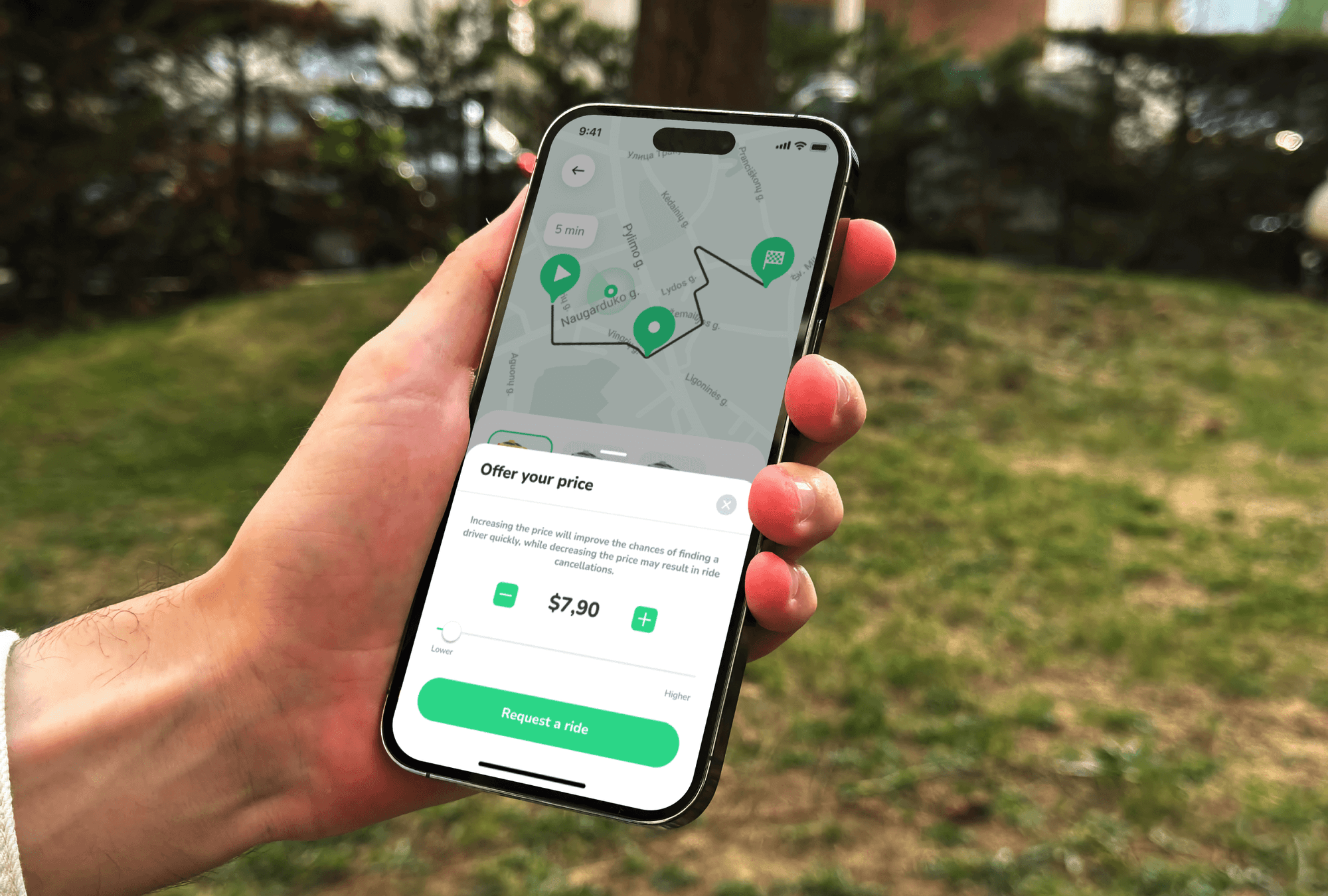
What it is
A flexible pricing feature that lets passengers propose their own fare - higher or lower than the system-calculated price, within limits set by the operator. Drivers see the offer instantly and can choose to accept or reject it.
Who it helps
Ride-hailing operators in competitive, price-sensitive, or highly dynamic markets where price shifts demand quickly.
How it works
When requesting a ride, the user selects “Offer your price”. A slider or +/– buttons allow them to adjust the fare within operator-defined boundaries. If the user lowers the price, the app explains that the offer may reduce the chance of driver acceptance.
Drivers see a clear banner showing whether the rider is offering more or less than the standard fare. Drivers can accept or decline based on their preference.
Operators can enable or disable the feature per vehicle class.
Why it matters
- Creates a clear differentiator in markets dominated by fixed-fare competitors
- Helps convert riders who compare multiple apps before booking
- Gives drivers more control over their earnings and decisions, improving transparency and satisfaction
- Supports better ride matching during off-peak hours or less profitable routes
- Allows operators to experiment with more flexible pricing strategies without changing their core fare model

What it is
A lightweight, embeddable booking widget that lets customers reserve a rental vehicle directly from your website - without installing the mobile app first. It’s designed to capture spontaneous bookings, convert website visitors, and unify online and in-app rental experiences.
Who it helps
Car, moped, and bike rental operators, as well as hospitality and tourism partners such as hotels, resorts, coworking spaces, real-estate developers, and travel service providers.
How it works
Every operator receives a branded rental URL: merchantname.atommobility.com/rent
Users select their area, vehicle type, and rental period directly in the widget. Once confirmed and the account created, the booking syncs automatically into the ATOM Mobility dashboard. Customers see a confirmation screen with a QR code to open the booking in the mobile app. Payment, ID verification, and vehicle unlock actions are completed in the ATOM Mobility-powered app before the trip begins.
The widget automatically adapts to the operator’s brand color for a visually seamless integration. In the dashboard, each booking displays its source: App, Web, or Booker - helping operators track where rentals originate.
Why it matters
- Converts first-time users browsing your website into paying customers - without forcing an app install
- Enables plug-and-play rental flows for partners such as hotels, rental desks, cafés, coworking spaces, or tourist spots
- Supports QR-based rental journeys from physical locations
- Reduces friction for users who want a fast, simple booking experience
- Helps operators expand distribution with minimal effort, unlocking new sales channels
- Unifies online and mobile rental flows under a single backend and operational system
Demo: https://app.atommobility.com/rental-widget

What it is
Bad user experiences often happen when several riders encounter the same faulty vehicle. ATOM Mobility now prevents this automatically. Automation rules detect problematic vehicles and instantly set them to “Needs investigation,” hiding them from the user app so the operator can inspect the vehicle before the next rider can take it.
Who it helps
Sharing and rental operators managing medium or large fleets.
How it works
System monitors low ratings, repeated short rides, and user reports. When triggered, it:
- creates a maintenance task
- switches vehicle status
- hides the vehicle from users
Why it matters
- Prevents recurring complaints from the same issue
- Reduces refunds and reputational damage
- Helps maintain a healthier, more reliable fleet
- Automates routine operational checks
What was added
2025 brought a wave of new integrations that give operators more flexibility in choosing hardware, payments, charging, and regulatory tools. What was added:
- Ridemovi IoT
- Wave payment gateway
- Linka smart lock support
- 2Hire IoT
- Kuhmute charging stations
- Eskiz.uz OTP service
- Atmos payment gateway
- Chiron API (regulatory)
- Fitrider charging station
- Azericard payment gateway
Why it matters
- Easier entry into markets with local payment or OTP requirements
- More hardware options for scooters, bikes, e-bikes, and cars
- Better compatibility with charging infrastructure
- Reduced integration time when expanding
- Support for regulatory compliance where required
These ten features represent only a small selection of what we delivered this year. In total, our team shipped more than 70 new features, dozens of integrations, and countless small improvements that quietly make the platform faster, more stable, and more enjoyable for operators and end-users every single day. Behind each release is a team focused on one idea: helping entrepreneurs build stronger, more efficient, and more profitable mobility businesses.
And we’re just getting started.
Our 2026 tech pipeline is already packed with ambitious and exciting solutions - from deeper AI-powered automation to smarter fleet intelligence and new tools that will change how operators run mobility services. We're looking forward to pushing the industry even further together.
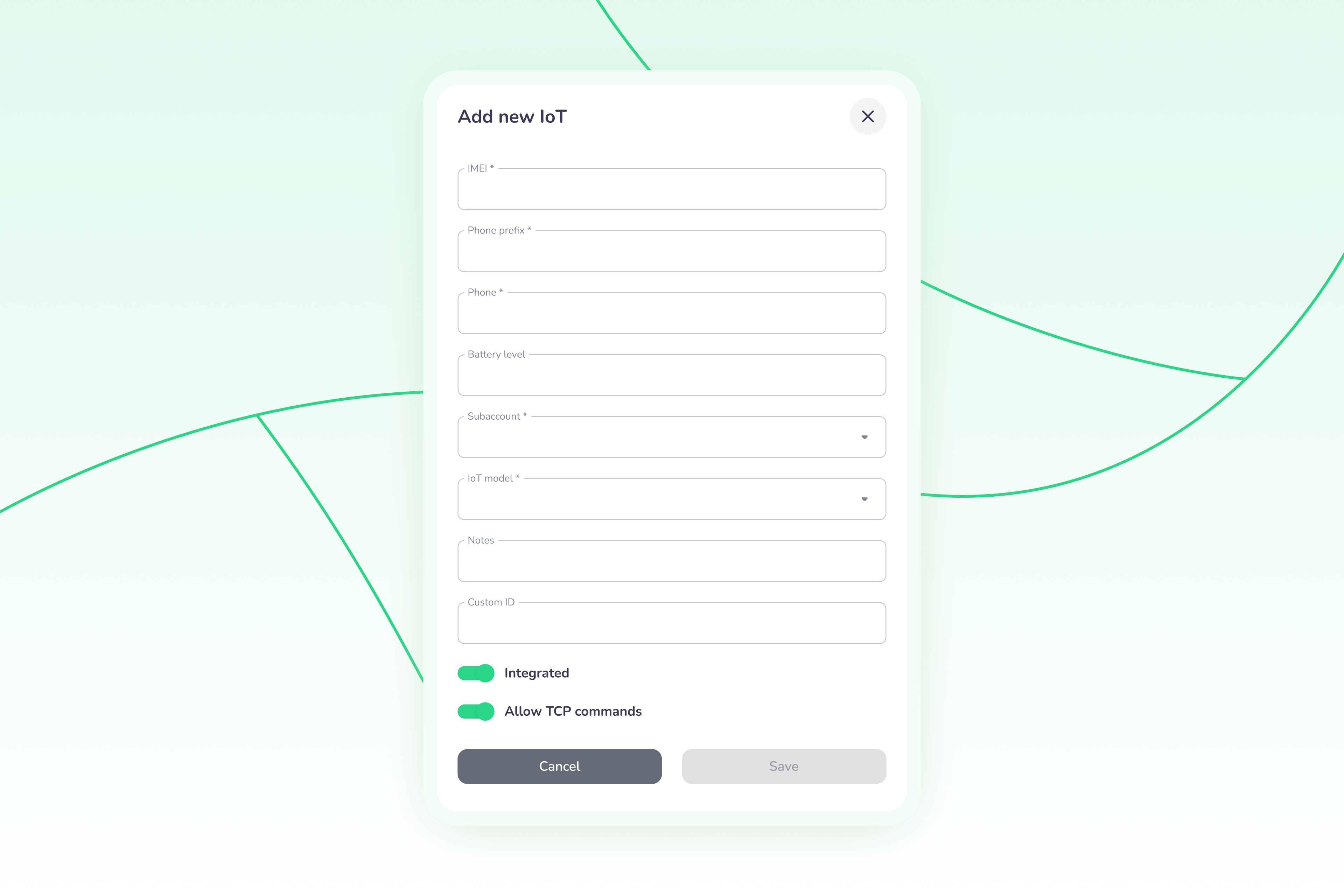
🛴📡 That smooth ride you just took? It was powered by a whole ecosystem of hardware and software you never saw. From IoT modules in the vehicle to real-time dashboards and rider apps, shared mobility relies on a solid tech stack to stay online, secure, and profitable.
You open an app, spot a scooter on the map, and within seconds it unlocks with a click. You ride off, expecting the battery to be charged, the brakes to work, and the whole process to feel effortless. From the very first ride, shared mobility set the standard: vehicles should always be nearby, ready to go, and the whole experience should feel seamless. What most riders never think about, though, is the complex mix of hardware and software working in the background to make every smooth ride possible.
Technology is the baseline for the shared mobility business model. Every ride depends on it. Vehicles need IoT hardware to lock, unlock, and report their status. Connectivity has to be stable so operators always know where assets are and what condition they’re in.
On the software side, riders expect apps that feel instant and intuitive, while operators rely on dashboards for fleet health, pricing, and support. Add in the realities of theft, battery swaps, downtime, and local regulations, and the stakes become clear. Without a reliable tech stack, even small failures – a scooter that won’t unlock or a payment that stalls – can quickly break user trust and hurt the business.
Over the years, several manufacturers have entered the shared mobility IoT space, offering different hardware configurations, network technologies, and integrations. Companies like Teltonika (Lithuania), Comodule (Estonia), Invers (Germany), OMNI (China) and others produce modules compatible with various vehicle types and connectivity standards. Each provider focuses on specific strengths – some prioritize energy efficiency or compact design, others emphasize global coverage or advanced diagnostics. Choosing between them depends on the type of vehicles, operational scale, and software ecosystem an operator plans to use.
Our partner, Comodule was already developing IoT for micromobility when the Corona pandemic hit. Overnight, cities shifted and everyone needed their own safe, private way to move around. Shared scooters and bikes suddenly went from being a niche service to an essential part of urban transport, and the demand for IoT skyrocketed. For IoT manufacturers, it meant long days in development and manufacturing, pushing hard to deliver reliable devices at scale for brands like Uber, Lime, and Hive.
That sharp rise in demand forced them to grow quickly and gave valuable experience in building technology that could perform under real pressure. Fleets that trusted Comodule devices had a backbone they could rely on: vehicles that could be located, unlocked, secured, and managed internationally. Just as important, the IoT had to integrate seamlessly with software systems (like ATOM Mobility). That’s why building robust API and SDK tools became critical – enabling operators to connect hardware to their platforms, control fleets in real time, and access the information needed to keep moving.

Inside every connected scooter or bike sits a IoT module, the “brain” that links the vehicle to the cloud. It connects through cellular networks, constantly sending data about location, speed, and battery status. When a rider taps “unlock” in the app, that command travels through the cloud to the module, which triggers the electronic lock and wakes up the vehicle. The same connection allows operators to set geofenced no-parking zones, push over-the-air updates, or activate a sound alarm if the scooter is being tampered with. Battery sensors inside the module report charging cycles and health, so operators know exactly when a pack needs to be swapped or replaced.
All of this data is streamed in real time to the fleet management system, giving providers the ability to monitor hundreds or even thousands of vehicles simultaneously. For operators, these capabilities mean higher uptime, faster theft recovery, and precise control over the entire fleet – the difference between running a struggling operation and a profitable one.
As shared mobility matured, the bar kept getting higher. New scooter generations came with swappable batteries, sturdier frames, and better onboard electronics. Riders got used to apps that respond instantly, process payments in seconds, and show vehicle availability with pinpoint accuracy.
At the same time, competition rose, not only from global players but also from smaller, local operators launching fleets in their own cities. For these companies, reliable hardware was no longer enough. They needed the software layer that connects everything: smooth rider apps, powerful operator dashboards, and analytics to make smarter decisions. Yet many lacked the time and resources to build software on their own.

As fleets grew and competition intensified, operators realized they did not have time or funds to develop their own software layer. They needed a market-ready platform that ties everything together – apps that riders enjoy using and dashboards that give operators full control of their business. That’s where solutions like ATOM Mobility come in.
Platform connects directly with Comodule IoT through APIs and SDKs, so every unlock command, error code, or battery update flows instantly between the rider’s app and the operator’s dashboard. Almost any company can launch a fleet with this stack – from large-scale operators to small, local newcomers.
When hardware and software work seamlessly, the rider experience feels effortless. A simple tap in the app sends a command through the cloud to IoT, which unlocks the vehicle and streams live data back in milliseconds. The operator instantly sees the vehicle’s status in the dashboard: battery level, GPS position, and any error codes.
If the scooter leaves a geofenced area, the system reacts automatically. If maintenance is needed, the alert is flagged before it becomes a breakdown. By combining the hardware with software, fleet providers get one complete ecosystem – a stack built to keep vehicles online and users satisfied.
From a rider’s perspective, shared mobility should always “just work.” That won’t change. But the technology stack behind it is becoming more sophisticated every year. Stricter regulations demand safer and more transparent services, while cities are pushing for integration into broader Mobility-as-a-Service platforms. IoT and software together provide the data and control that operators need, not only to stay compliant but also to improve fleet efficiency and sustainability and to provide insights for city planning.
For users, that sophistication will translate into something simple: services that are more reliable, safer for everyone on the road, and smarter – with data from real-world usage helping to shape better vehicles, better infrastructure, and better cities in the future.
*This article was created together with our partner Comodule.

🚗 The car rental industry is finally catching up with modern mobility. From Norway to Mexico, users are skipping the desk and unlocking their rental cars with just a tap on their phone. Paper contracts, front desks, and "similar model" surprises are being replaced by fast, app-based experiences. Operators like Hyre, Sixt, and Avis are proving that going digital boosts revenue and improves customer satisfaction.
The car rental industry is finally going digital. Not with just a website and an app, but with a real transformation of how rentals work – from booking to unlocking the vehicle. Customers no longer want paper contracts, counters, or “similar model” surprises. They want convenience, predictability, and self-service.
That’s exactly what happened at Norway’s largest airports, where traditional rental giant Europcar lost its presence to Hyre – a local operator offering a mobile-first, fully digital blend of car rental and sharing. But it’s not just new players like Hyre pushing this shift. Established giants like Sixt and Avis are rapidly digitalising their rental flow as well – rolling out features like app-based bookings, mobile ID verification, and keyless access across key markets.
At ATOM Mobility, we’ve helped operators move toward this digital future for over seven years. The goal is simple: modernise outdated processes, improve the user experience, and create more profitable operations. And right now, the timing for this shift couldn’t be better.
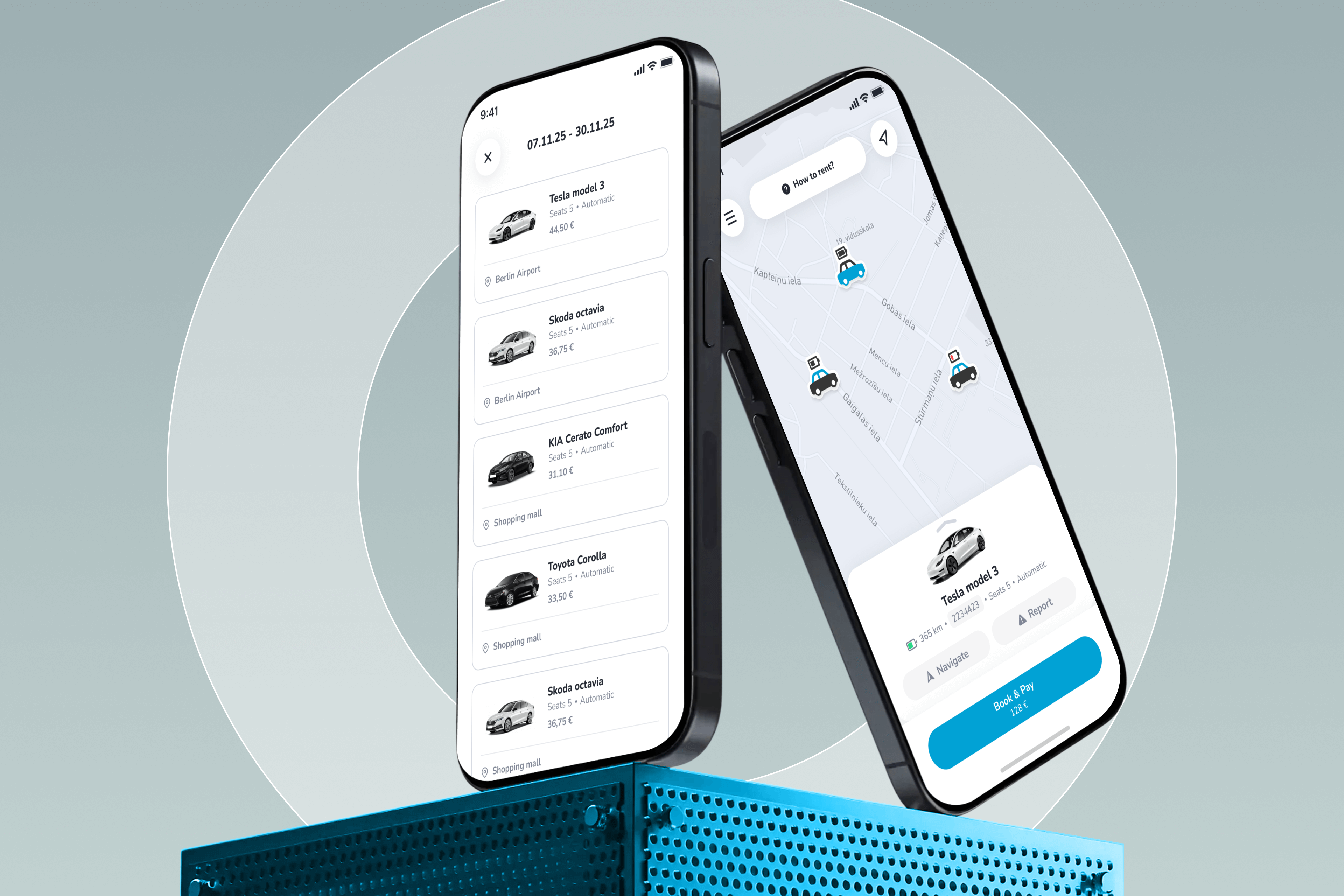
From counters to apps: Why the rental experience is changing
Customer expectations have changed. Today’s users – especially younger ones and business travellers – are used to seamless, mobile-first journeys. They don’t want to queue at a desk, hand over their ID, wait for paperwork, or discover they’re getting a different car than they booked. And in many cases, they simply won’t accept it.
Hyre’s model responds to this new demand:
And the results are impressive:
This shift is not just a trend in Norway. It’s a glimpse of where the car rental market is heading across Europe and beyond.
What users gain from a digital rental experience
The benefits for customers are obvious – and powerful:
This is what the modern traveller wants: clarity, control, and speed.
Why operators are embracing digitalisation
While the user benefits are clear, the real business case lies in how much better digitalisation makes operations:
Real examples: Hyre, Sixt, Avis, and Beyond
These companies understand that digitalisation isn’t about offering an app – it’s about rebuilding the rental experience around the user. And it's paying off.
What this means for operators (and how ATOM Mobility can help)
If you’re running a rental operation and still relying on paperwork, front desks, or disconnected tools, now’s the time to evolve.
Here’s how you can modernise your operations with help from ATOM Mobility:
ATOM Mobility provides all the building blocks to power this shift. Whether you’re a traditional rental company l
ooking to go mobile-first, or a new operator exploring flexible mobility, we’ve built the tech to get you there.
The rental counter is going away
Car rental is becoming more like e-commerce: fast, digital, and customer-led. The counter, the queue, the paperwork – these are all parts of an older model that no longer meets expectations. The future lies in seamless, app-based access that lets users pick the car they want, when they want it.
The Hyre example shows what’s possible with the right model. Sixt and Avis show how even large incumbents are adapting. If you’re an operator – big or small – the time to start this shift is now.
And if you’re looking for a trusted partner to support you on that journey, ATOM Mobility digital rental software is ready. We help rental and car sharing businesses launch, scale, and thrive – with the tech that powers modern mobility.


When global players skipped smaller cities, Elerent saw opportunity. They built a franchise-first network that now spans 60+ cities across Southern Europe. After migrating from another platform that struggled with complex IoT (10+ device types!), they found a scalable partner in ATOM Mobility.
🌍 When global players skipped smaller cities, Elerent saw opportunity. They built a franchise-first network that now spans 60+ cities across Southern Europe. After migrating from another platform that struggled with complex IoT (10+ device types!), they found a scalable partner in ATOM Mobility - and now they’re even taking on ride-hailing with WOPPH, a new Italian alternative to Uber.
When Alessio Treglia first encountered shared scooters on a trip to Lisbon in 2019, he instantly saw potential. At the time, Italy had no similar micromobility services, and the simplicity of the scooter-sharing experience – especially how easy it was through the app – left a strong impression.
That moment led to the creation of Elerent, a company that now operates in more than 60 cities across Italy, Malta, Greece, and Spain. Built entirely on a franchise model, Elerent empowers local entrepreneurs to run their own fleets under a unified brand and tech platform. Today, Elerent is expanding across new cities, vehicle types, and even business models – including a ride-hailing app called WOPPH, designed specifically for the Italian market.
Launch date: June 2020. Migrated to ATOM Mobility in May 2025
Country: Italy, Malta, Greece, and Spain
App downloads: Over 100,000 (Android)
App rating: 4,7 / 5 from 965+ reviews (Google Play) and 4.6 / 5 from 1600+ reviews (App Store)
Fleet: Over 4,000 vehicles across 60+ cities
Web page: https://elerent.com
App Store: https://apps.apple.com/it/app/elerent/id1518090808
Google Play: https://play.google.com/store/apps/details?id=com.elerent.elerent
Starting with inspiration – and a delayed launch
Alessio was already managing several businesses in Italy when he came across Tier scooters in Lisbon. Curious about the model and impressed by how easily it worked, he returned to Rome with the idea of starting something similar. He began researching the sector, gathered insights from local entrepreneurs, and launched a pilot project. Everything was ready by early 2020, but the pandemic delayed the official launch. Instead of stopping, Alessio used that time to study the market more deeply and refine the model. In June 2020, the first Elerent city went live.
Focusing on cities the big players skipped
From the start, Elerent’s strategy was clear: avoid direct competition with large operators like Dott or Bird in crowded urban centres. Instead, the team focused on small and mid-sized cities, especially those with strong tourism traffic. The franchise model made this possible. Local partners handled daily operations and worked directly with municipalities, while Elerent provided the brand, tech platform, and support. This approach allowed the company to scale efficiently, without needing large operational teams in each location.
One supplier per vehicle type
Elerent began with scooters, later adding bikes, mopeds, and in some cities, cars. Scooters are still the most popular option across their network, especially in resort towns. Bike sharing is growing fast and has become a key focus for expansion. Mopeds, on the other hand, have proven more complex to manage and scale. To keep things efficient, the team prefers working with a single hardware supplier per category. For scooters, that’s mostly Segway. Standardizing hardware has made training, maintenance, and spare part sourcing easier across all cities.
.jpeg)
Running the business day-to-day
Each city is run by a local entrepreneur who manages deployment, maintenance, and local relationships. These franchisees are incentivised to ensure smooth operations – they earn directly from ride revenue. Elerent monitors each location using a few simple metrics: average rides per vehicle per day, and how many vehicles are active. This helps the team identify issues like maintenance delays or low demand, and offer support where needed. “They know their cities better than we ever could,” Alessio explains. “That’s why the model works.”
Switching platforms and finding the right tech
Before partnering with ATOM Mobility, Elerent had worked with several other fleet management platforms. Alessio is direct about what he learned through that experience: frequent migrations are expensive, risky, and damaging to customer trust. “Every migration costs you money, time, and reputation,” he says. “That’s why it’s so important to choose the right software partner early and stick with them.”
After testing different solutions, Alessio chose ATOM Mobility based on the platform’s reliability, flexibility, and partner-first approach. “We found a solid product that does what we need it to do,” he says. “It’s stable, it’s scalable, and it supports our franchise structure and multi-vehicle operations across many cities. That’s not easy to find.”
He also values the working relationship. “The ATOM team actually listens. We’ve been able to suggest changes and improvements, and they respond fast,” he adds. “They understand how operators think. It’s not just a software provider – it’s a real partner.”
Smarter decisions with AI
To improve fleet performance and decision-making, Elerent has integrated Switch’s Urban Copilot – an AI-driven tool that supports operators with actionable data insights. “Everyone talks about AI, but this is one of the only tools that actually delivers results,” says Alessio. “We don’t have our own analytics team, but with Switch, we get the insights we need to make better decisions.”
Supporting local launches
Whenever a new city goes live, Elerent supports the franchisee with launch marketing, hands-on training, and operational onboarding. This includes local promotions with hotels and restaurants, technical setup, and on-the-ground support during the first week of service. The goal is to make each new launch consistent, reliable, and locally relevant.
.jpeg)
WOPPH: An alternative to ride-hailing in Italy
WOPPH (pronounced “wopp”) is Elerent’s newest product – a ride-hailing app designed specifically for the Italian market, where traditional platforms like Uber are limited to taxi dispatching. WOPPH allows private individuals to offer rides to others, using a peer-to-peer model that fits within the local legal framework. Users can book rides, view pricing, and track arrivals – all through the app (powered by ATOM Mobility). The service has already launched in Rome and is set to expand to ten more cities in the coming months.
WOPPH is also experimenting with other modes of transport, including golf carts, delivery vehicles, and even private planes for day trips. The app will also allow users to turn their personal vehicles into shared cars using IoT devices – letting drivers choose between offering rides or enabling self-service access. “It’s an ambitious product,” Alessio says. “But the market response has been very positive.”
Looking ahead: growth through opportunity
Alessio believes the timing is right for continued expansion. With hardware costs falling and large operators focusing more on profitability than growth, there’s room for companies like Elerent to expand into new markets, especially with second-hand vehicles. “We can buy nearly-new units from major suppliers at half the price,” he says. “That opens a lot of doors.”
The focus now is on growing Elerent’s reach, continuing to support franchisees, and scaling WOPPH into a national mobility platform. With multiple projects moving forward in parallel, Elerent is positioning itself as a flexible, tech-enabled operator in markets that global players often overlook.

🚗💬 Why do ride-hail drivers quit – and what makes them stay? We break down insights from the 2025 Gig Driver Report and show how ATOM Mobility helps platforms keep drivers happy with instant payouts, dynamic pricing, and smarter tools.
How to retain drivers on your ride-hailing platform long term
In the ride-hailing business, getting enough drivers online is critical. But keeping them there is what really drives long-term success. Unlike traditional taxi services, ride-hailing drivers are independent contractors. They don’t have fixed shifts, guaranteed income, or long-term contracts. They log on when it suits them, and just as quickly, they can log off – or switch to another app.
That flexibility means you're not only competing for riders. You're also competing for drivers, every single day.
What makes ride-hailing different for drivers
Compared to traditional taxis, the ride-hailing model offers drivers more independence but less security. Taxi drivers usually worked under a dispatcher, used company-owned vehicles, and followed a set schedule. Ride-hailing drivers use their own car, their own time, and often multiple apps.
The benefits are clear: flexibility, lower entry barriers, and instant access to earnings. But the downsides are just as real: unpredictable income, lack of support, and platform instability. For platforms, that means driver loyalty is fragile. Small changes – like delayed payments or fewer rides – can cause drivers to leave.
Why driver retention matters
Most ride-hailing operators focus heavily on passenger growth. But without enough reliable drivers, demand turns into frustration. When wait times grow or no vehicles are available, users abandon the app. This makes driver retention a key metric – not just for operations but also for brand trust and profitability.
It’s more expensive to onboard a new driver than to keep an experienced one. A stable driver base delivers smoother rides, higher ratings, and better service coverage. If your drivers are churning every few weeks, your entire operation becomes reactive.

Inside the 2025 Gig Driver Report
A recent survey by Everee sheds light on what drivers want - and what makes them quit. In May 2025, 419 gig drivers in the U.S. were surveyed. Most of them worked across multiple apps, including Uber, Lyft and Shipt. The full findings are available in the 2025 Gig Driver Report by Everee.

Key findings:
These numbers show how sensitive drivers are to delays, unclear policies, and inefficiencies. A small friction point in your system could be enough to push them to a competitor.
Why drivers leave
The survey also highlighted the most common reasons drivers stop working with a platform:
In short, if drivers feel their earnings or control are at risk, they move on. The ride-hailing industry is too competitive for platforms to assume drivers will stay loyal without constant support and improvement.
What platforms can do to retain drivers
To retain drivers long term, platforms need to act on what drivers value most. According to the same report, the top three areas that would increase loyalty are:
Additionally, drivers want to feel that their time is respected, their safety is prioritized, and that they are not left guessing about payments or platform changes.
How ATOM Mobility helps you build driver loyalty
With ATOM Mobility’s platform, ride-hailing operators have access to several features designed specifically with drivers in mind.
The “Offer Your Price” feature allows riders to bid slightly more during high demand or bad traffic conditions, giving drivers the chance to earn extra when it matters most.
Dynamic pricing lets operators automatically raise fares during weekends, holidays, or peak hours so that drivers earn more when demand spikes.
One of the most impactful tools is the instant revenue split system, where a driver’s commission is transferred directly to their Stripe Connect account after every successful ride. This eliminates waiting times and builds trust through real-time, transparent payouts.
To make things even smoother, ATOM Mobility offers a dedicated driver app where drivers can track performance, see earnings, and review ride history.
All of this adds up to a professional, transparent experience for drivers - and a stronger incentive to stay on your platform long term.
A dedicated driver app helps drivers track performance, earnings, and ride history. This kind of visibility increases engagement and reduces confusion. Instead of contacting support for payment questions, drivers can see everything directly in the app. The experience feels more professional and structured – which increases the chance they’ll stay longer.
You can explore the dedicated driver app in more detail on driver app overview.
Faster onboarding leads to faster activation
Another key piece of retention is how quickly drivers can get started. Platforms that make onboarding long or confusing lose drivers before the first ride. ATOM Mobility supports streamlined onboarding flows with pre-filled fields, automatic document validation, and built-in guides. In some cases, drivers can be onboarded, verified, and ready to drive within hours – not days.
A better experience creates loyalty
Drivers are not just users of your app – they are ambassadors of your brand. Every interaction they have, from the first sign-up to the latest payout, shapes how they feel about your platform. If it’s smooth, fair, and rewarding, they’re likely to stay. If not, they’ll be gone before the next weekend rush.
By investing in the right tools and understanding what really matters to drivers, platforms can reduce churn, increase satisfaction, and build a loyal driver base. And in a market where supply is everything, that loyalty pays off.
If you're building a ride-hailing operation and want to give your drivers a reason to stay, ATOM Mobility gives you the technology to make it happen. From instant payments to dynamic pricing and a dedicated driver app, everything is designed to keep your fleet active and engaged – for the long haul.